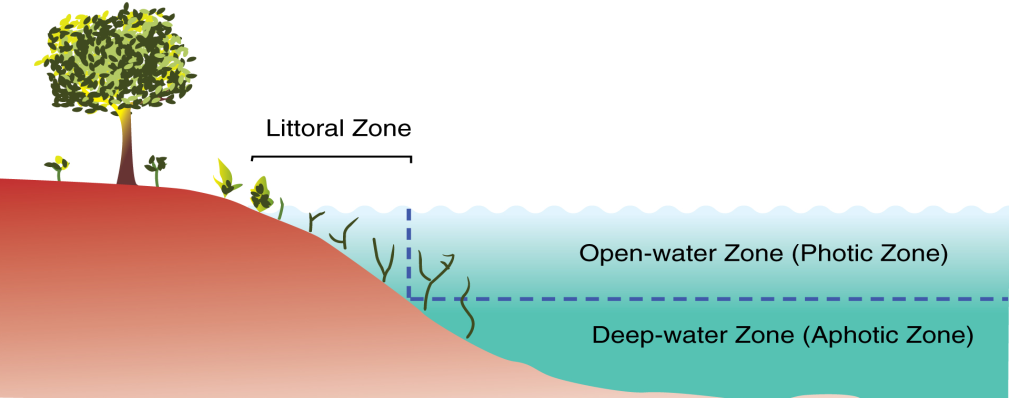
Draw a lake showing different zones. Why are they called so?
Answer
540.3k+ views
Hint: They provide shelter for plants and animals that are marine and semi-aquatic. Green plants provide nourishment in which any single living amphibian is based. They would subsequently be named autotrophs.
Complete answer:
Three areas or sub-territories in lentic waters are generally isolated: littoral, limnetic, and benthic. A small lake can consist entirely of a coastal region. The lake consists of three areas.
1) Coastal zone: The region near the coast where sunlight penetrates into the sediments and enables aquatic plants to expand.
2) Limnetic region: A zone with an exposed field of water in which light does not penetrate to the bottom. It is a plankton and nekton zone.
3) Benthic zone: The lake's bottom is composed of coral reefs, scallops and mussels.
Lakes are categorized as follows based on productivity:
1) Oligotrophic lakes: Poor primary productivity and low biomass levels combined with low nitrogen and phosphorus concentrations (nutrients). They seem to be oxygen-saturated.
2) Mesotrophic lakes: Lakes in the transition from oligotrophic environments to eutrophic ones. During summer stratification, such oxygen saturation depression occurs in the hypolimnion.
3) Eutrophic lakes: These display elevated nitrogen concentrations, high productivity of biomass and low transparency. The concentration of oxygen in the hypolimnion can get very low during the season.
4) Hypereutrophic lakes: These are lakes with extremely high nitrogen concentrations at the maximum edge of eutrophication and related development of biomass. During season, anoxia or total oxygen deprivation occurs in the hypolimnion.
5) Dystrophic lakes: These are fertile organic lakes fed by the lake's external inputs.

Note: For a certain group of species, Lake's productivity is the production rate, basically reflecting the net growth rate of organisms. Lakes rarely suffer from water scarcity, but because of the lack of nutrients needed for plant growth and reproduction, they are also unproductive.
Complete answer:
Three areas or sub-territories in lentic waters are generally isolated: littoral, limnetic, and benthic. A small lake can consist entirely of a coastal region. The lake consists of three areas.
1) Coastal zone: The region near the coast where sunlight penetrates into the sediments and enables aquatic plants to expand.
2) Limnetic region: A zone with an exposed field of water in which light does not penetrate to the bottom. It is a plankton and nekton zone.
3) Benthic zone: The lake's bottom is composed of coral reefs, scallops and mussels.
Lakes are categorized as follows based on productivity:
1) Oligotrophic lakes: Poor primary productivity and low biomass levels combined with low nitrogen and phosphorus concentrations (nutrients). They seem to be oxygen-saturated.
2) Mesotrophic lakes: Lakes in the transition from oligotrophic environments to eutrophic ones. During summer stratification, such oxygen saturation depression occurs in the hypolimnion.
3) Eutrophic lakes: These display elevated nitrogen concentrations, high productivity of biomass and low transparency. The concentration of oxygen in the hypolimnion can get very low during the season.
4) Hypereutrophic lakes: These are lakes with extremely high nitrogen concentrations at the maximum edge of eutrophication and related development of biomass. During season, anoxia or total oxygen deprivation occurs in the hypolimnion.
5) Dystrophic lakes: These are fertile organic lakes fed by the lake's external inputs.

Note: For a certain group of species, Lake's productivity is the production rate, basically reflecting the net growth rate of organisms. Lakes rarely suffer from water scarcity, but because of the lack of nutrients needed for plant growth and reproduction, they are also unproductive.
Recently Updated Pages
Master Class 12 English: Engaging Questions & Answers for Success

Master Class 12 Economics: Engaging Questions & Answers for Success

Master Class 12 Social Science: Engaging Questions & Answers for Success

Master Class 12 Maths: Engaging Questions & Answers for Success

Master Class 12 Chemistry: Engaging Questions & Answers for Success

Master Class 12 Business Studies: Engaging Questions & Answers for Success

Trending doubts
What are the major means of transport Explain each class 12 social science CBSE

Which are the Top 10 Largest Countries of the World?

Draw a labelled sketch of the human eye class 12 physics CBSE

Explain sex determination in humans with line diag class 12 biology CBSE

The pH of the pancreatic juice is A 64 B 86 C 120 D class 12 biology CBSE

Explain sex determination in humans with the help of class 12 biology CBSE




